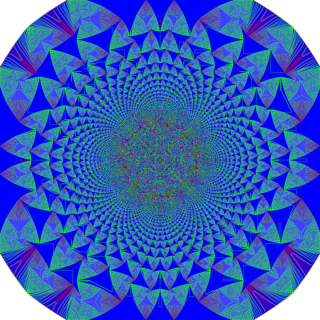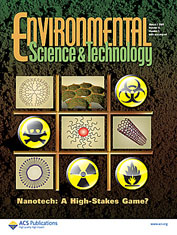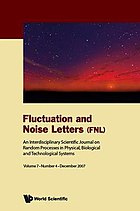Physical Review Letters (PRL), established in 1958, is a peer-reviewed, scientific journal that is published 52 times per year by the American Physical Society. As also confirmed by various measurement standards, which include the Journal Citation Reports impact factor and the journal h-index proposed by Google Scholar, many physicists and other scientists consider Physical Review Letters to be one of the most prestigious journals in the field of physics.

Self-organized criticality (SOC) is a property of dynamical systems that have a critical point as an attractor. Their macroscopic behavior thus displays the spatial or temporal scale-invariance characteristic of the critical point of a phase transition, but without the need to tune control parameters to a precise value, because the system, effectively, tunes itself as it evolves towards criticality.
Quantum 1/f noise is an intrinsic and fundamental part of quantum mechanics. Fighter pilots, photographers, and scientists all appreciate the higher quality of images and signals resulting from the consideration of quantum 1/f noise. Engineers have battled unwanted 1/f noise since 1925, giving it poetic names due to its mysterious nature. The Quantum 1/f noise theory was developed about 50 years later, describing the nature of 1/f noise, allowing it the be explained and calculated via straightforward engineering formulas. It allows for the low-noise optimization of materials, devices and systems of most high-technology applications of modern industry and science. The theory includes the conventional and coherent quantum 1/f effects (Q1/fE). Both effects are combined in a general engineering formula, and present in Q1/f noise, which is itself most of fundamental 1/f noise. The latter is defined as the result of the simultaneous presence of nonlinearity and a certain type of homogeneity in a system, and can be quantum or classical.

Organic Letters is a biweekly peer-reviewed scientific journal covering research in organic chemistry. It was established in 1999 and is published by the American Chemical Society. In 2014, the journal moved to a hybrid open access publishing model. The founding editor-in-chief was Amos Smith. Since 2019, Erick M. Carreira serves as the editor-in-chief. The journal is abstracted and indexed in: the Science Citation Index Expanded, Scopus, Academic Search Premier, BIOSIS Previews, Chemical Abstracts Service, EMBASE, and MEDLINE.
A quantum critical point is a point in the phase diagram of a material where a continuous phase transition takes place at absolute zero. A quantum critical point is typically achieved by a continuous suppression of a nonzero temperature phase transition to zero temperature by the application of a pressure, field, or through doping. Conventional phase transitions occur at nonzero temperature when the growth of random thermal fluctuations leads to a change in the physical state of a system. Condensed matter physics research over the past few decades has revealed a new class of phase transitions called quantum phase transitions which take place at absolute zero. In the absence of the thermal fluctuations which trigger conventional phase transitions, quantum phase transitions are driven by the zero point quantum fluctuations associated with Heisenberg's uncertainty principle.

Optics Letters is a biweekly peer-reviewed scientific journal published by Optica. It was established in July 1977. The editor-in-chief is Miguel Alonso. The journal covers all topics pertaining to optics and photonics. Publishing formats are short and rapid communications, with articles being limited to four journal pages.
Foundations of Physics is a monthly journal "devoted to the conceptual bases and fundamental theories of modern physics and cosmology, emphasizing the logical, methodological, and philosophical premises of modern physical theories and procedures". The journal publishes results and observations based on fundamental questions from all fields of physics, including: quantum mechanics, quantum field theory, special relativity, general relativity, string theory, M-theory, cosmology, thermodynamics, statistical physics, and quantum gravity

Journal of the Physical Society of Japan (JPSJ) is a monthly, peer reviewed, scientific journal published by the Physical Society of Japan (JPS). It was first published in July 1946. The editor-in-chief was A. Kawabata until August 2010. The impact factor for JPSJ in 2017 is 1.485, according to Journal Citation Reports.

Environmental Science & Technology is a biweekly peer-reviewed scientific journal published since 1967 by the American Chemical Society. It covers research in environmental science and environmental technology, including environmental policy. Environmental Science & Technology has a sister journal, Environmental Science & Technology Letters, which publishes short communications.
Nonlinearity is a peer-reviewed scientific journal published by IOP Publishing and the London Mathematical Society. The journal publishes papers on nonlinear mathematics, mathematical physics, experimental physics, theoretical physics and other areas in the sciences where nonlinear phenomena are of fundamental importance. The Editors-in-Chief are Tasso J Kaper for IOP Publishing and Konstantin Khanin for the London Mathematical Society.
Modelling and Simulation in Materials Science and Engineering is a peer-reviewed scientific journal published by the IOP Publishing eight times per year.

Laszlo Bela Kish is a physicist and professor of Electrical and Computer Engineering at Texas A&M University. His activities include a wide range of issues surrounding the physics and technical applications of stochastic fluctuations (noises) in physical, biological and technological systems, including nanotechnology. His earlier long-term positions include the Department of Experimental Physics, University of Szeged, Hungary, and Angstrom Laboratory, Uppsala University, Sweden (1997–2001). During the same periods he had also conducted scientific research in short-term positions, such as at the Eindhoven University of Technology, University of Cologne, National Research Laboratory of Metrology, University of Birmingham, and others.

Nano Letters is a monthly peer-reviewed scientific journal published by the American Chemical Society. It was established in January 2001. The editor-in-chief is Teri W. Odom. The journal covers all aspects of nanoscience and nanotechnology and their subdisciplines.

The Journal of Materials Science is a weekly peer-reviewed scientific journal covering all aspects of materials science. It was established in 1966 by Robert W. Cahn and is published by Springer Science+Business Media. The journal incorporated Journal of Materials Science Letters in 2003 and Interface Science in 2004. The Editor-in-Chief is C. Barry Carter.

The European Biophysics Journal is published by Springer Science+Business Media on behalf of the European Biophysical Societies Association. The journal publishes papers in the field of biophysics, defining this as the study of biological phenomena using physical methods and concepts. It publishes original papers, reviews and letters. The journal aims "to advance the understanding of biological structure and function by application of the principles of physical science, and by presenting the work in a biophysical context". The editor-in-chief of the journal is Robert Gilbert.
The Journal of Physical Chemistry Letters is a peer-reviewed scientific journal published by the American Chemical Society. The editor-in-chief is Gregory D. Scholes at Princeton University. The Journal of Physical Chemistry Letters covers research on all aspects of physical chemistry. George C. Schatz was editor-in-chief from 2010 to 2019.

Earth and Planetary Science Letters (EPSL) is a bimonthly peer-reviewed scientific journal covering research on physical, chemical and mechanical processes of the Earth and other planets, including extrasolar ones. Topics covered range from deep planetary interiors to atmospheres. The journal was established in 1966 and is published by Elsevier. The co-editors-in-chief are J. Adkins, J.P. Avouac, R. Bendick, L. Derry, M. Ishii, T.A. Mather, W.B. McKinnon, F. Moynier, Chiara Maria Petrone, Hans Thybo, Alexander Webb.

The Journal of Colloid and Interface Science is a peer-reviewed scientific journal published by Elsevier. It covers research related to colloid and interface science with a particular focus on colloidal materials and nanomaterials; surfactants and soft matter; adsorption, catalysis and electrochemistry; interfacial processes, capillarity and wetting; biomaterials and nanomedicine; and novel phenomena and techniques. The editor-in-chief is Martin Malmsten. The journal was established in 1946 as Journal of Colloid Science. It obtained its current name in 1966.
Biomicrofluidics is a bimonthly peer-reviewed scientific journal covering all aspects of research on fundamental physicochemical mechanisms associated with microfluidic, nanofluidic, and molecular/cellular biophysical phenomena in addition to novel microfluidic and nanofluidic techniques for diagnostic, medical, biological, pharmaceutical, environmental, and chemical applications. The editors-in-chief are Hsueh-Chia Chang and Leslie Y. Yeo.
Symmetry is a monthly peer-reviewed open access scientific journal published by MDPI covering several aspects of theories and applications related to symmetry/asymmetry phenomena in the natural sciences. The journal was established in 2009 and the editor-in-chief is Sergei Odintsov. The journal features occasional special issues on specific selected topics.











